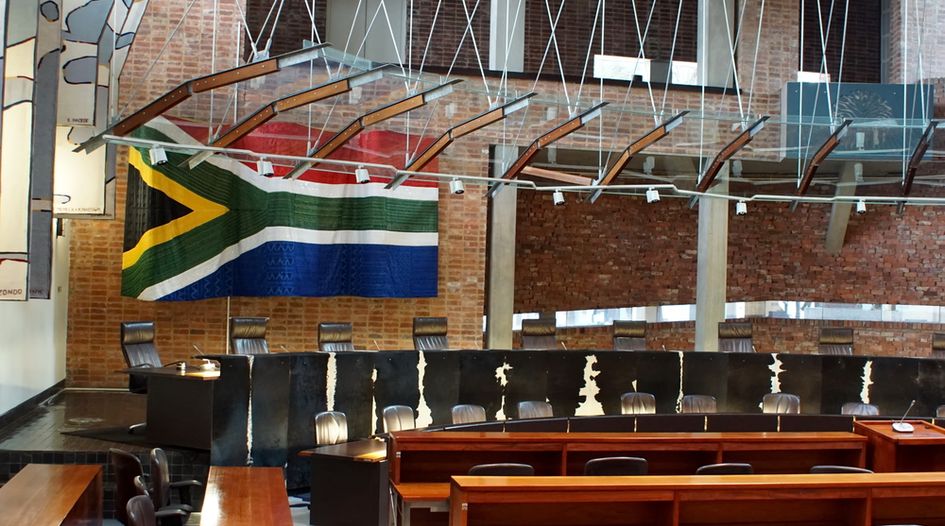South Africa: Targeted law is already scoring big wins against domestic fakes

This is an Insight article, written by a selected partner as part of WTR's co-published content. Read more on Insight
Legal framework
CGA
South Africa’s Counterfeit Goods Act 37 of 1997 (CGA) aims to combat the trade in counterfeit goods. It was implemented in conjunction with amendments to the Merchandise Marks Act 17 of 1941 (MMA), which had previously been the principal weapon used to deal with counterfeit goods. All provisions of the MMA concerning counterfeit goods have now been stripped, and their counterparts moved to the CGA.
Before the CGA, the only pieces of domestic legislation that provided any measure of relief against trade in counterfeit goods were the MMA, the Copyright Act 1978 and the Trademarks Act 1993. The provisions of those acts have largely been found wanting as they create offences only in respect of some forms of trading in counterfeit goods. They also lack appropriate and effective mechanisms, procedures and penalties for combating trade in counterfeit goods.
The CGA is intended to enable owners of registered trademarks, copyrights and marks protected under the MMA to take action against the counterfeiting of their products and to provide streamlined and effective enforcement measures. It brings South Africa into compliance with certain provisions of the Agreement on Trade-Related Aspects of Intellectual Property Rights, to which the country is a party.
The CGA allows inspectors to search and enter premises to seize counterfeit goods. It is an offence for a person to, among other things, manufacture, import, have counterfeit goods in his or her possession or control, or exhibit such goods in public for purposes of trade.
Proceedings under the CGA are subject to strict technical requirements and deadlines. Once the holder or licensee (or another interested party) of an IP right has lodged a complaint with a designated inspector, the inspector may obtain a warrant to enter and inspect any premises or vehicle and to seize and confiscate any suspected counterfeit goods located therein.
The practical definition of counterfeit goods
In practical terms, ‘counterfeit goods’ are defined to be goods that unlawfully bear or embody a trademark or the copyright of another without authorisation, or that have the appearance of the goods of another. To constitute an act of counterfeiting, the act must infringe (or give rise to the infringement of) a trademark right, copyright or both.
Counterfeit goods in practice
Counterfeit goods are imitations of goods that embody an IP right, or goods that bear spurious marks that infringe articles in respect of an IP right. In manufacturing, producing or making such goods, or applying the subject matter of an IP right to them, a person so doing commits an act of copyright or trademark infringement, or contravenes the MMA.
The CGA does not extend to rights conferred by the Patents Act or the Designs Act.
Initiating the seizure of counterfeit goods
Provision is made for the appointment of inspectors, namely:
- any police official as defined in Section 1(1) of the Criminal Procedure Act that has the rank of sergeant or higher;
- certain customs and excise officials; and
- any person designated as an inspector by the minister of trade and industry in a notice published in the Government Gazette.
Inspectors have wide-ranging powers to search for, seize and detain goods that are suspected to be counterfeit.
The CGA confers certain powers on inspectors, whether they are acting on their own initiative or after having received a complaint from someone with an interest in the goods that are the target of counterfeiting. Provided that there are reasonable grounds to believe that an act of dealing in counterfeit goods is taking place, inspectors may enter any premises or vehicle and search for counterfeit goods and seize and remove those that are (or that are reasonably suspected of being) counterfeit.
Dealing in counterfeit goods
The CGA prohibits certain conduct relating to counterfeit goods. These include:
- having goods in the possession or control of any person in the course of business for the purpose of dealing in them;
- manufacturing, producing or making goods except for the private and domestic use of the person by whom they were manufactured, produced or made;
- selling, hiring out, bartering or exchanging goods, or offering or exposing goods for sale, hire, barter or exchange;
- exhibiting goods in public for trade;
- distributing goods;
- importing goods into or through South Africa, or exporting goods from or through South Africa, except for the private and domestic use of the importer or exporter, respectively; or
- in any manner disposing of goods in the course of trade.
Section 2(2) of the CGA, which is the heart of the Act, provides that any person who performs or engages in any prohibited conduct relating to counterfeit goods will be guilty of an offence if:
- at the time of the act or conduct, they knew (or had reason to suspect) that the goods to which the act or conduct relates were counterfeit; or
- they failed to take all reasonable steps to avoid any act or conduct of the nature contemplated in Section 2(1) from being performed or engaged in concerning counterfeit goods.
Lodging a complaint with an inspector
A complainant is someone with an interest in protected goods (including his or her lawyer, agent or representative), regardless of whether they are the holder or licensee of an IP right, or an importer, exporter or distributor of protected goods. It is common practice for lawyers to depose to the affidavit of complaint on behalf of the rights holder. Under the CGA, such a person is entitled to lodge a complaint with an inspector.
The complainant must lodge a complaint. This usually takes the form of an affidavit, in which the following material allegations must be made:
- an act of dealing in counterfeit goods has been, is being or is likely to be committed (the allegation must be based on a reasonable suspicion, and the affidavit of complaint should contain sufficient facts from which it can be concluded that an act of dealing in counterfeit goods, has been, is being or is likely to be committed).
- information and particulars to the satisfaction of the inspector that the alleged counterfeit goods are prima facie counterfeit goods; and
- sufficient information and particulars on the subsistence and extent of the relevant IP right.
Inspector’s reaction
An inspector who is reasonably satisfied that the complaint complies with the provisions of the CGA is entitled to take various steps if the complainant’s suspicions appear to be reasonable. In order to conduct a search and seizure raid, an inspector must obtain a warrant (from a judge or magistrate having jurisdiction), except in certain exceptional circumstances. The issuing of the warrant will entitle the inspector to take various search and seizure steps. When no complaint has been laid, the inspector may, in certain circumstances, act on his or her initiative concerning any act or conduct believed (or suspected) to be an act of dealing in counterfeit goods, subject to prescribed constraints.
Post-search and seizure procedure
Once an inspector has undertaken the search and seizure operation, they must give written notice of the seizure to the suspect and the complainant, specifying the actions taken and the address of the depot where the seized goods will be stored. This notice will state the complainant’s right to lay a criminal charge against the suspect within three days. No period is prescribed for when this notice must be given; however, current police practice requires that it must be issued immediately.
Seizure of goods
An inspector who has seized any suspected counterfeit goods will seal them and record an inventory. This must be checked for correctness and certified by the person from whom those goods are seized. The seized goods must be stored in safe custody at a designated counterfeit goods depot until its manager is ordered by the court or inspector to return, release, destroy or otherwise dispose of them. The complainant will be responsible for monthly storage costs while the goods remain in the depot. These costs may be recovered should the complainant pursue civil proceedings against the suspect.
Relief available to complainants under the act
In addition to the quick and effective seizure of counterfeit goods by inspectors, the CGA empowers the courts to order, among other things:
- that goods found to be counterfeit be delivered to the holder of the relevant IP right (or a complainant deriving title from the right holder), irrespective of the outcome of the proceedings;
- that the accused or defendant disclose the source from which the counterfeit goods have been obtained and the identity of the persons involved (or ostensibly involved); and
- damages in an amount determined by it, as well as costs, to the suspect.
Other available measures include:
- cease and desist letters or letters of demand (which are often the first legal step and are used in matters where the quantity of goods is low, and the costs of pursuing litigation would not be justified); or
- instituting civil litigation against the perpetrator.
Usually, civil proceedings are instituted where the CGA may not apply (eg, in cases of trademark or copyright infringement that do not fall within the ambit of the CGA). Civil proceedings will also be invoked in cases relating to patents, designs, plant breeders’ rights and common law rights for passing off and unlawful competition.
Border measures
Section 15 of the CGA deals with the powers of customs authorities regarding counterfeit goods that are imported into South Africa. The holder of an IP right may apply to the commissioner of customs to seize and detain all goods that are suspected to be counterfeit and that are imported into or exported from South Africa during the period specified in the application.
The Commissioner has implemented a specific policy for the implementation of Section 15, and rights holders are encouraged to record their rights with the Commissioner. Once an application is accepted, it is valid for 10 years.
In practice, when an application is filed and accepted by the commissioner, customs officials at all ports of entry will be notified of the application and will keep a watchful eye out for suspected counterfeit products bearing the IP rights referred to in the application. When a consignment of suspected counterfeit goods is detected, the customs authorities will detain it and immediately notify the right holder or its local representative (usually the right holder’s local lawyers).
Samples of the suspected counterfeit goods will be made available for inspection, and Customs will require an affidavit (within five working days) confirming the counterfeit nature of the detained goods. If this is not provided, the goods will be released to the importer. The right holder may request an extension.
Having filed the affidavit, the customs official will then (in their capacity as an inspector) apply for a search and seizure warrant and formally seize the offending goods. The post-search and seizure operation procedure also applies to customs seizures.
Domestic customs authorities encourage rights holders to meet with their officials for brand identification training and to furnish any information that will assist and enable the officials to prevent the importation of counterfeit goods into South Africa.
Criminal prosecution
If, following the issuing of a seizure notice, the complainant wishes to bring criminal charges with the police against the suspect for dealing in counterfeit goods, and to request a criminal investigation, they must do so within three days of that notice being issued. If no charges are brought within three days, the seized goods must be released to the suspect unless the complainant exercises their right to institute civil proceedings.
Where a criminal charge is brought, the state must, within 10 working days of the seizure notice having been issued, inform the suspect in writing of its intention to institute a criminal prosecution for having dealt in counterfeit goods. If this notice is not given, the seized goods must be returned to the suspect, unless the complainant has exercised their right to institute civil proceedings. The State must then issue the criminal summons within 10 days of the aforementioned notice.
Offences and penalties
An individual convicted of dealing in counterfeit goods is liable, in the event of a first conviction, to a maximum fine of 5,000 rand for each article to which the offence relates or imprisonment for up to three years, or both. In the case of a subsequent offence, the maximum fine increases to 10,000 rand and the maximum period of imprisonment increases to five years.
Civil enforcement
If a complainant wishes to institute civil proceedings against a suspect, they must give written notice (within 10 days of the issue of the seizure notice) of their intention to do so; otherwise, the seized goods must be returned to the suspect unless the state has notified the suspect of pending criminal prosecution. Having given written notice to the suspect, the state (or the prospective plaintiff in civil proceedings) must institute the proceedings within 10 working days; otherwise, the seized goods must be returned to the suspect.
It is essential for rights holders who intend to pursue a matter under the CGA to understand these post-seizure requirements.
Anti-counterfeiting online
Unauthorised internet commerce
Counterfeit goods are typically sold online through mainstream social media platforms or from independent websites. However, a growing trend is to advertise counterfeit goods on a social media platform with a link directing consumers to the website. Although the CGA remains the primary legislation for takedown notices, relief can also be sought from general legislation. In the instance of an online payment, the Electronic Communications and Transactions Act 25 of 2002 (ECTA) holds that any seller must provide a sufficient description of the characteristics of the goods they are selling to enable the consumer to make an informed decision – meaning a disclosure that the goods sold are not genuine. Failure to do so empowers a consumer to cancel the transaction within 14 days of receiving the counterfeit goods.
Online investigation strategies
There are two primary routes to identifying counterfeit goods online: (1) automatic monitoring using sophisticated tracking software and artificial intelligence; and (2) conducting manual searches – specialised searching services are available to perform this role. Both can be effective. However, manual searches introduce a human element that can identify discreetly disguised counterfeit items as well as new counterfeiting practices. Where these are discovered, an investigator would pose as a customer and attempt to elicit as much information as possible on the suspect’s operations, especially to determine whether it is a seller or manufacturer and conduct a test purchase. If the test purchase is confirmed to be counterfeit, an aggressive strategy of online takedowns, suitable letters of demand and/or offline enforcement action can be initiated.
ISP liability
Under the ECTA, internet service providers (ISPs) will not be held liable for solely providing access to the Internet and transmitting the data. However, an ISP must perform a take-down of the website upon receiving a bona fide complaint of infringing content being displayed, such as that of counterfeit goods. This is not the only way to obtain a website takedown; the ECTA also makes provisions for a competent court to order a service provider to terminate or prevent unlawful activity in terms of any other law – including the provisions of the CGA.
Preventive measures and strategies
Use of local counsel and investigators
Owing to the sophisticated nature of the illegal activities conducted by particular importers, manufacturers and distributors, IP rights holders must develop an investigative strategy to combat dealing in counterfeit goods. Local counsel and investigators who specialise in anti-counterfeiting law can be of great assistance in advising and recommending appropriate strategies.
Control of contractual relationships with third parties
If rights holders license the manufacturing of their goods to third parties, the contractual relationship must be controlled. There have been instances where the sources of counterfeit goods and grey goods have been traced back to a licensee or third-party manufacturer of the right holder. Controlling the contractual relationship is, in itself, a preventative measure.
Cooperation with national anti-counterfeiting agencies
To ensure that rights holders take full advantage of the anti-counterfeiting programmes in South Africa, they must develop relationships with local law enforcement agencies such as the police and Customs. The police and Customs encourage rights holders to visit their offices and furnish appropriate brand identification training to their members and officials.




